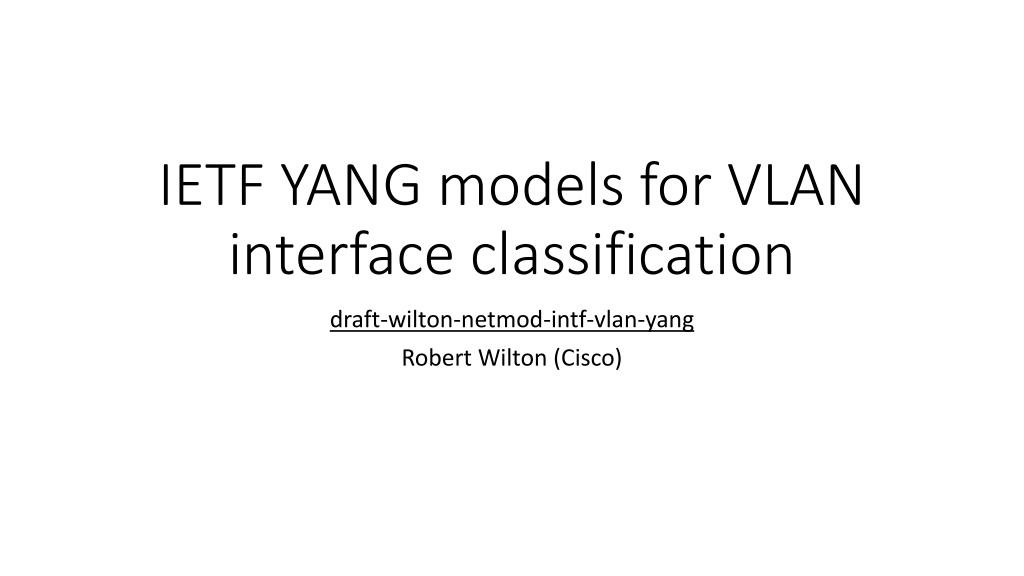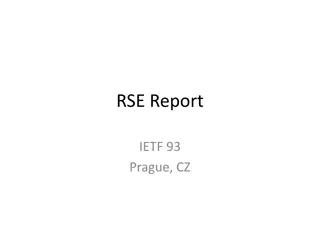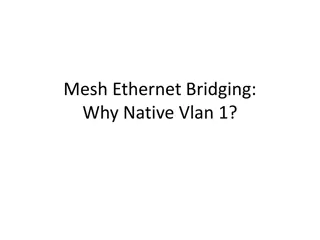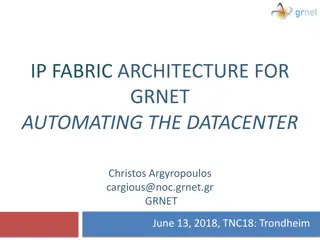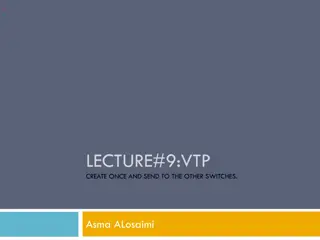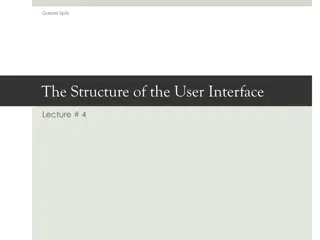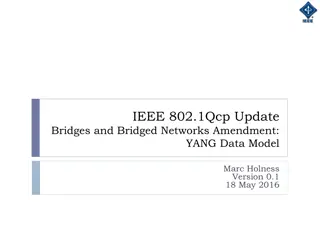Understanding VLAN Interface Classification in IETF YANG Models
This content delves into the concept of interfaces in networking, focusing on child interfaces. It explains the need for child interfaces to apply separate feature and forwarding rules to specific traffic subsets. The discussion covers the characteristics of interfaces, the hierarchy of child interfaces under parent interfaces, demux classification using VLAN IDs, and the flexibility of child interfaces in network configurations.
Download Presentation

Please find below an Image/Link to download the presentation.
The content on the website is provided AS IS for your information and personal use only. It may not be sold, licensed, or shared on other websites without obtaining consent from the author. Download presentation by click this link. If you encounter any issues during the download, it is possible that the publisher has removed the file from their server.
E N D
Presentation Transcript
IETF YANG models for VLAN interface classification draft-wilton-netmod-intf-vlan-yang Robert Wilton (Cisco)
Presentation Objectives To explain what this IETF model is trying to achieve To justify why this is being standardized in IETF To hopefully get agreement from IEEE 802.1 that it is acceptable for IETF to standardize this model Without this model a lot of standard IETF protocols are unconfigurable via YANG, or unusable with 802.1Q VLAN tagged traffic! Draft is currently blocked in IETF at the equivalent of the PAR phase we don t want to antagonise IEEE 802.1 by starting a project that conflicts with IEEE.
What is an interface? Based on the IFMIB & ietf-interfaces.yang, an interface can be defined as a generic container with the following characteristics: It identifies a stream of network traffic (potentially at any layer) It is an anchor point to apply features and protocol forwarding configuration on that stream of traffic It has an interface type (IANA defines many different flavours) It has a default set of traffic statistics It can be enabled/disabled via configuration
What is a child interface? Why is it needed? (1) Sometimes it is necessary to apply the feature and forwarding rules to a subset of traffic on an interface This can be modelled cleanly using child-interfaces: Child interfaces Parent interface E.g. Phy Ethernet, LAG, Pseudo-wire, Traffic forwarded by IP in VRF x Traffic forwarded by IP in VRF y Traffic forwarded via VPLS instance
What is a child interface? Why is it needed? (2) A child interface is a type of interface that allows separate feature and forwarding rules to be applied to a subset of the traffic of any parent interface. Feature/forwarding schema paths are the same as for any other type of interface! Lots of different parent interface types can have child interfaces: Physical Ethernet, LAG, Pseudo-wire Headend, Bridge virtual interface, Frame Relay, ATM, A parent interface can have many child interfaces if required Multiple layers of interface hierarchy are possible Classification rules are used to demux traffic from a parent interface to its children interfaces For interfaces with Ethernet framing VLAN Ids are often used as the demux classification Forwarding is configured via other IETF protocol YANG models (IPv4, IPv6, MPLS, Pseudowires, VPLS, EVPN, L2TPv3)
What isnt a child-interface? It is not just traffic associated with a particular single VLAN Id It is far more flexible, matching on sets of tags, or other fields. It has no predefined forwarding semantics Forwarding models can just refer to an if:interface without caring about what type of interface it is, or whether it is a parent or child. IETF forwarding models work with VLANs with no extra changes required. It is not an alternative way of configuring an IEEE 802.1Q bridge Mostly devices that implement child interfaces don t implement IEEE 802.1Q bridging, although there is no reason why they can t coexist on the same device. A LAG member is not a child interface A different relationship is required because there are N LAG members to one LAG, and no explicit demux is required.
Why standardize? Why in IETF? Many vendors have proprietary configuration constructs similar to what is being proposed. No existing standards exist for this technology in any standards body because historically the end user configuration has not been standardized. However, there is now a strong market demand for automation via standard YANG models. Many IETF forwarding YANG models are incomplete without being able to configure them on VLAN child interfaces. IETF is the right place because IETF owns the generic interface model, this is just an extension and VLANs are one example.
Clearing up other areas of confusion Q. Doesn t ietf-interfaces already model this? No, it has read-only leaves for operational state, separate configuration leaves are required. Q. Is the long term plan for IEEE to adopt ownership of this model? No, this model covers different technology/protocols to those standardized in IEEE. Q. Does this model allow different VLAN traffic on different LAG member interfaces? No, this model can t be used for LAG membership. Q. Will this model redefine VLAN types? No, it will be updated to use the IEEE defined types where possible - we may request that some additional ones get added/defined by IEEE.
Next steps? Can we reach agreement for the draft to proceed in IETF as a WG document from this meeting? Otherwise what is required to unblock it: A formal liaison from IETF to IEEE? Presenting at the next IEEE plenary/interim? In the meantime I will continue to incorporate feedback and evolve the model (on the assumption that it will eventually get unblocked
Backup slide More generic picture of how child interface can be used to configure different forwarding services. L2 child interface connected to a Pseudowire PW MPLS PW HE L3 child-interface L3/VRF L3 Physical interfaces with 802.1Q tagged traffic classified to child- interfaces VPLS or PWs BVI PW VPLS VPLS Physical interface with 802.1Q tagged traffic classified to child-interfaces Local Connect
